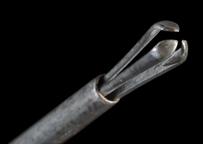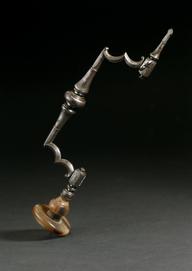









Coconut goblet, mounted in silver, carved with 3 scenes in the life of a barber surgeon, possibly by Gill, York, late 17th century
These carvings show three scenes in the life of a barber-surgeon. One shows a bloodletting scene, a common treatment for a number of illnesses and diseases. The other scenes show a customer waiting for a haircut and shave and a patient with a bandage on his head and who is also waiting to be seen. The coconut would have been a novelty as these were new to England in the 1600s.
Although the practical links between the professions of barber and surgeon are long gone, the historical connection lives on in the red and white striped poles which can still be found outside some barbers. A common practice of barber-surgeons was bloodletting and the poles still seen today symbolise the clean (white) and bloodstained (red) bandages associated with the practice. They are entwined around a pole which is reminiscent of the staff grasped by those about to be bled from the arm.
Look closer
Coconut GobletDetails
- Category:
- Surgery
- Collection:
- Sir Henry Wellcome's Museum Collection
- Object Number:
- A641076
- Measurements:
-
overall: 192 mm 115 mm, 0.368 kg
- type:
- goblet
- credit:
- Willett, E.




